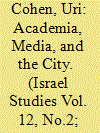|
|
|
Sort Order |
|
|
|
Items / Page
|
|
|
|
|
|
|
| Srl | Item |
| 1 |
ID:
078549


|
|
|
|
|
| Publication |
2007.
|
| Summary/Abstract |
What were the conditions that encouraged the opening of the civic university in Tel-Aviv? What is the part of public opinion in reshaping the higher education system? This article explores the relationship between different interpretive concepts on institutions of higher education in the first decade of Israel's existence. Analysis of the media discourse around the foundation of the university in Tel-Aviv, points out that it is an essential context for understanding the formation of public opinion. More specifically, it helps to understand the paths as an innovative idea spread from marginal and insignificant newspapers to become a dominant strategy that was adopted by the municipality. By this we want to emphasize and to clarify the important and crucial role of the civic society that was raised against the power of the government and hegemonic university
|
|
|
|
|
|
|
|
|
|
|
|
|
|
|
|
| 2 |
ID:
078546


|
|
|
|
|
| Publication |
2007.
|
| Summary/Abstract |
What does it mean to be religious in a secular, western, modern society? Emuna Elon's novel, Heaven Rejoices, engages this question through a story of two intertwined love affairs: one thwarted-a previously orthodox mother's youthful unconsummated love for a future rabbi and leader in the settler community, and one realized-her orthodox daughter's love for his son. This paper first identifies three categories of cultural expression among orthodox Israelis-reformist, voyeuristic, and pedagogical. The paper then examines how the novel, a pedagogical artifact, simultaneously captures the ambivalences and tensions embedded in the contemporary orthodox experience and suggests a resolution that hinges on a differentiation between "orthodox", "ultra-orthodox", and "secular". I conclude that in its attempt to chart purportedly clear boundaries between these social categories the novel partakes in broader cultural negotiations between orthodox traditionalists and reformists about the face and future of Israeli orthodoxy.
|
|
|
|
|
|
|
|
|
|
|
|
|
|
|
|
| 3 |
ID:
078547


|
|
|
|
|
| Publication |
2007.
|
| Summary/Abstract |
This article is a condensation of research that was made for a recently published album on Passover haggadot in the kibbutz. The album is a detailed account of the creative work of a few generations of kibbutz members
|
|
|
|
|
|
|
|
|
|
|
|
|
|
|
|
| 4 |
ID:
078550


|
|
|
| 5 |
ID:
078544


|
|
|
| 6 |
ID:
078545


|
|
|
|
|
| Publication |
2007.
|
| Summary/Abstract |
The article describes the internal debate within Religious Zionist circles over the question of Jews entering the Temple Mount and presents the internal religious dynamics that permitted Jews to enter. It presents the positions of the Mercaz Harav yeshiva, one of the most important halachic centers of modern-day religious Zionism, whose leaders reject the idea of Jews entering the Temple Mount in the current era. The article further describes the debate on the question of entering the Temple Mount within the Chief Rabbinate, whose plenum strongly negated such a possibility, although some leading members of the rabbinate permitted entry and prayer in an individual capacity. This is followed by a discussion of the decision by the Council of Yesha Rabbis (a group of Orthodox rabbis from the settlements in Judea, Samaria, and the Gaza Strip) permitting Jews to enter the Temple Mount, under certain Halachic restrictions, and of the debate their decision evoked among Religious Zionist rabbis. The article presents the clear phenomenon of the erosion and weakening of the prohibition against Jews entering the Temple Mount. It is difficult to ignore the growing support for this approach among ever wider circles
|
|
|
|
|
|
|
|
|
|
|
|
|
|
|
|
| 7 |
ID:
078548


|
|
|
|
|
| Publication |
2007.
|
| Summary/Abstract |
The song "Jerusalem of Gold", one of contemporary Israel's inalienable culture's assets, represents a unique cultural phenomenon: Four decades have passed since it was written by Naomi Shemer-a leading producer of modern Israel's popular music-yet its status remains that of a national symbol or unofficial national anthem. This status is reflected in the fact that, among other things, it is frequently heard during public ceremonies relating to Israel locally and internationally. Even though "Jerusalem of Gold" represents an exceptional phenomenon in Israel's cultural space, it has generated marginal academic interest. In an attempt to understand the special status of the song, this article has explored events during the first significant phase in its social construction period, just before and immediately after the Six Day War. This study exposed the way in which the song's initial spontaneous success benefited from two growing forces: The song fitted wonderfully into the "IDF's heroism festival" and at the same time it suited the "spiritual-religious festival", both products of Israel's stirring victory in the Six Day War. This article sheds light on a song as a fascinating juncture of politics, national symbols, and popular culture. Following Regev and Seroussi who argue that popular music is the cultural form that most strongly signifies Israeliness [Israelliut], the article uses the multidimensional cultural construction of the song "Jerusalem of Gold" as a microcosm of Israeli society for the purpose of studying post-1967 "Israeliness
|
|
|
|
|
|
|
|
|
|
|
|
|
|
|
|
|
|
|
|
|